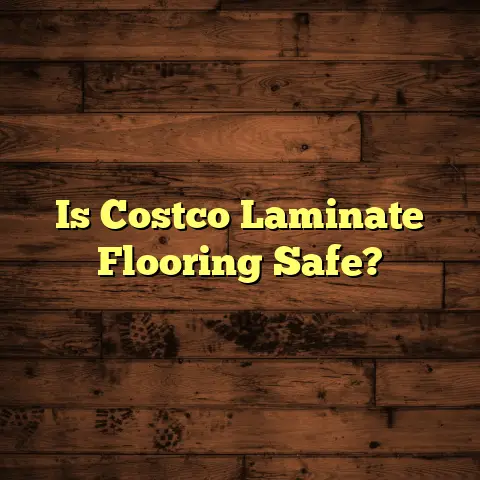Is Your Tile Sealed? (5 Second Test!)
I’m a flooring contractor, and I’ve seen it all when it comes to tile.
From stunning porcelain masterpieces to crumbling natural stone disasters.
And believe me, one of the biggest culprits behind those disasters? Neglecting to seal your tile properly, or at all!
But it’s not just about aesthetics. In today’s world, we’re all trying to be a little more eco-conscious, right?
Well, properly maintaining your tile floors isn’t just good for your wallet, it’s good for the planet too.
Think about it: the longer your floors last, the less often you have to rip them out and replace them. That means less waste going to landfills and less energy spent manufacturing new materials. It’s a win-win!
Plus, choosing eco-friendly tiles made from recycled materials or sustainably sourced resources is a fantastic first step. But even the most “green” tile needs protection.
That’s where sealing comes in. It prolongs the life of your floors, reduces the need for harsh cleaning chemicals, and ultimately contributes to a more sustainable lifestyle.
Ready to dive in? Let’s talk about tile, sealing, and that super simple “5 Second Test” that can save you a ton of headaches.
Section 1: Understanding Tile and Its Types
Okay, so let’s start with the basics. What exactly is tile, and what are the different types you’ll find in most homes?
Well, broadly speaking, tile is a hard-wearing material used to cover floors, walls, and countertops. It’s durable, easy to clean, and comes in a mind-boggling array of styles and colors.
But the “tile” umbrella covers a lot of ground. Here’s a quick rundown of the most common types:
-
Ceramic Tile: This is your workhorse tile. It’s made from clay that’s been fired at high temperatures. Ceramic is relatively inexpensive, water-resistant, and comes in tons of designs.
-
Porcelain Tile: Think of porcelain as ceramic’s tougher, more sophisticated cousin. It’s made from a finer clay and fired at even higher temperatures, making it denser, more durable, and less porous than ceramic.
-
Natural Stone Tile: This category includes materials like granite, marble, slate, and travertine. Natural stone offers a unique, luxurious look, but it’s also the most porous and requires the most maintenance.
-
Glass Tile: Glass tile is exactly what it sounds like: tile made from glass. It’s non-porous, stain-resistant, and adds a beautiful, reflective quality to any space.
Now, here’s the key takeaway: not all tiles are created equal when it comes to porosity.
Ceramic and porcelain are relatively dense, but natural stone is incredibly porous. That means it has tiny little holes that can absorb water, stains, and even bacteria. Yikes!
That’s why sealing is so important, especially for natural stone. Without a good sealant, your beautiful marble floor could quickly become a stained, unsightly mess. And nobody wants that.
Section 2: The Importance of Sealing Tiles
So, we’ve established that sealing is important. But why is it so crucial?
Well, think of sealant as a protective shield for your tile. It creates a barrier that prevents water, oil, and other liquids from penetrating the surface.
This is especially important in areas that see a lot of moisture, like bathrooms, kitchens, and entryways.
An effective sealant does several things:
-
Protects Against Water Damage: Water seeping into your tile can cause cracks, discoloration, and even mold growth.
-
Prevents Staining: Coffee spills, red wine, and even muddy footprints can leave permanent stains on unsealed tile.
-
Inhibits Bacterial Growth: Porous tiles can harbor bacteria and other nasty microorganisms, especially in damp environments.
But let’s get back to that eco-conscious angle. How does sealing benefit the environment?
Well, for starters, it reduces the need for harsh cleaning chemicals. When your tile is properly sealed, you can usually clean it with just soap and water. No need for those aggressive, chemical-laden cleaners that can harm the environment and your health.
More importantly, sealing extends the life of your flooring. According to the Tile Council of North America (TCNA), proper maintenance, including sealing, can significantly increase the lifespan of tile flooring. This means less waste going to landfills and less demand for new materials.
I’ve seen it firsthand. I’ve worked on homes where the tile was properly sealed and maintained, and it looked fantastic even after 20 years.
On the other hand, I’ve also seen homes where the tile was never sealed, and it was a disaster zone. Stained, cracked, and just plain gross.
Trust me, a little bit of sealing goes a long way.
Section 3: The 5-Second Test: A Quick Guide
Alright, let’s get to the good stuff: the “5 Second Test.”
This is a super simple way to determine if your tile is properly sealed. You don’t need any special equipment, just a little bit of water and a timer.
Here’s how it works:
1. Gather Your Materials: All you need is a small amount of water (a few drops will do) and a timer (your phone works perfectly).
2. Select a Tile Area to Test: Choose an area that gets regular use, like near the sink, in the shower, or by the entryway.
3. Place a Few Drops of Water on the Tile Surface: Just drip a few drops of water directly onto the tile.
4. Start the Timer and Observe the Water’s Behavior for Five Seconds: Watch closely and see what happens to the water.
Now, here’s what the results mean:
-
If the Water Beads Up: This is what you want to see! If the water forms a small, round bead on the surface of the tile, it means the sealant is working properly and preventing the water from being absorbed.
-
If the Water Seeps Into the Tile: Uh oh! If the water quickly spreads out and soaks into the tile, it means the sealant has worn off and your tile is vulnerable.
That’s it! Seriously, it’s that simple. I recommend doing this test in a few different areas of your home to get a good overall picture of your tile’s sealing status.
If you find that the water seeps in, don’t panic! It just means it’s time to reseal. We’ll get to that in a bit.
Section 4: Signs That Your Tile Needs Sealing
Okay, so the 5-Second Test is a great way to check your tile’s sealing status. But there are also other telltale signs that your tile might need some TLC.
Keep an eye out for these common indicators:
-
Discoloration or Staining of the Tiles: This is a big one. If you notice that your tile is starting to look dull, dirty, or stained, it’s a sign that the sealant is wearing off and allowing dirt and liquids to penetrate the surface.
-
Water Absorption or Pooling on the Surface: If water tends to sit on the surface of your tile instead of beading up, it means the sealant isn’t doing its job. You might also notice that the tile looks darker or damp in certain areas.
-
Increased Dirt Accumulation in Grout Lines: Grout is naturally porous, so it’s especially vulnerable to dirt and stains. If you find that your grout lines are constantly dirty, even after cleaning, it’s a sign that they need to be sealed (or resealed).
I remember one client who had beautiful travertine floors in her kitchen. She loved the natural look, but she never sealed them. Within a year, they were covered in coffee stains, grease splatters, and other unsightly marks.
She was so frustrated! She tried everything to clean them, but nothing worked. Finally, she called me in, and I told her the bad news: the only way to restore her floors was to have them professionally cleaned and sealed.
She learned her lesson the hard way. Don’t make the same mistake!
Section 5: How to Seal Your Tiles
Alright, so you’ve determined that your tile needs sealing. Don’t worry, it’s a pretty straightforward process that most homeowners can handle themselves.
Here’s a step-by-step guide:
1. Selecting the Right Sealant: This is crucial. You need to choose a sealant that’s specifically designed for your type of tile.
-
For Natural Stone: Use a penetrating sealant designed for porous materials like granite, marble, or slate. These sealants soak into the stone and create a barrier from within.
-
For Ceramic and Porcelain: You can use a topical sealant or a penetrating sealant. Topical sealants create a protective layer on the surface of the tile, while penetrating sealants soak into the grout lines and provide extra protection.
-
For Grout: Use a grout sealer specifically designed for grout lines. These sealants are typically applied with a small brush or applicator.
2. Preparing the Tile Surface: Before you can apply the sealant, you need to make sure the tile is clean and dry.
-
Clean the Tile: Use a mild detergent and water to remove any dirt, grime, or stains. Rinse thoroughly and allow the tile to dry completely.
-
Remove Existing Sealant (If Necessary): If you’re resealing tile that has already been sealed, you may need to remove the old sealant first. You can use a chemical stripper or a specialized tool for this purpose.
3. Applying the Sealant: Now for the fun part!
-
Read the Instructions: Always follow the manufacturer’s instructions carefully. This will tell you how much sealant to use, how to apply it, and how long to let it dry.
-
Apply the Sealant Evenly: Use a clean cloth, sponge, or paint brush to apply the sealant in a thin, even layer. Avoid applying too much sealant, as this can create a sticky or cloudy residue.
-
Wipe Away Excess Sealant: After applying the sealant, use a clean cloth to wipe away any excess. This will prevent the sealant from drying unevenly.
4. Curing Time and Testing: Once you’ve applied the sealant, you need to let it cure properly.
-
Allow Sufficient Drying Time: The manufacturer’s instructions will tell you how long to let the sealant dry. This can range from a few hours to 24 hours or more.
-
Test the Seal: After the sealant has dried, perform the 5-Second Test to make sure it’s working properly. If the water beads up, you’re good to go! If not, you may need to apply another coat of sealant.
Tips for Maintaining Sealed Tiles:
-
Clean Regularly: Wipe up spills and messes as soon as possible to prevent staining.
-
Use Mild Cleaners: Avoid using harsh chemicals or abrasive cleaners, as these can damage the sealant.
-
Reseal Periodically: Depending on the type of tile and the amount of traffic it receives, you may need to reseal it every 1-2 years.
Section 6: Eco-Friendly Sealant Options
Okay, so we’ve talked about the importance of sealing your tile. But what about the environmental impact of sealants themselves?
The good news is that there are now several eco-friendly sealant options available on the market. These sealants are typically made from natural ingredients and are free of harsh chemicals and VOCs (volatile organic compounds).
Here are a few examples of eco-friendly sealant ingredients:
-
Water-Based Polymers: These sealants use water as a carrier instead of harsh solvents.
-
Plant-Based Oils: Some sealants are made from natural oils like linseed oil or tung oil.
-
Beeswax: Beeswax is a natural sealant that can be used to protect grout lines.
Compared to traditional sealants, eco-friendly options offer several benefits:
-
Lower VOC Emissions: VOCs are harmful chemicals that can contribute to indoor air pollution. Eco-friendly sealants typically have lower VOC emissions, making them safer for your health and the environment.
-
Reduced Odor: Traditional sealants can have a strong, unpleasant odor. Eco-friendly sealants typically have a milder odor or no odor at all.
-
Biodegradable Ingredients: Some eco-friendly sealants are made from biodegradable ingredients, which means they’ll break down naturally over time.
Of course, it’s important to note that not all eco-friendly sealants are created equal. Some may not be as durable or effective as traditional sealants.
Do your research and choose a product that’s specifically designed for your type of tile and the level of protection you need.
Section 7: The Long-Term Benefits of Keeping Tiles Sealed
So, we’ve covered a lot of ground. We’ve talked about the importance of sealing tile, how to perform the 5-Second Test, how to seal your tile, and even eco-friendly sealant options.
But let’s take a step back and look at the big picture. What are the long-term benefits of keeping your tiles sealed?
Well, for starters, it can save you a ton of time and effort on cleaning. When your tile is properly sealed, it’s much easier to wipe up spills and messes. You won’t have to spend hours scrubbing stubborn stains or trying to get rid of that persistent grime.
Sealing also enhances the aesthetic appeal of your floors. Sealed tile looks cleaner, brighter, and more vibrant. It can also help to protect the color and pattern of your tile from fading or discoloration.
And let’s not forget about indoor air quality. As we discussed earlier, porous tiles can harbor bacteria and other nasty microorganisms. Sealing your tile can help to prevent this, creating a healthier indoor environment for you and your family.
But perhaps the most important benefit of sealing is that it extends the life of your flooring. By protecting your tile from water damage, staining, and wear and tear, you can significantly increase its lifespan.
This not only saves you money in the long run, but it also reduces the environmental impact of your home. Less waste going to landfills, less demand for new materials, and a smaller carbon footprint overall.
Conclusion: Embracing Eco-Conscious Practices in Home Maintenance
We started this journey talking about eco-consciousness and how it relates to something as seemingly simple as tile flooring.
Hopefully, I’ve shown you that even small steps in home care, like performing the 5 Second Test and choosing eco-friendly sealants, can lead to significant positive impacts.
It’s about being mindful of the materials we use, the products we choose, and the way we maintain our homes. It’s about making choices that are good for our wallets, our health, and the planet.
So, I encourage you to take action. Perform the 5 Second Test on your tile floors. Consider your options for sealing and maintaining them responsibly.
Remember, a little bit of effort can go a long way in creating a more sustainable and beautiful living space. And who knows, you might even enjoy the process!
Thanks for reading, and happy sealing!





